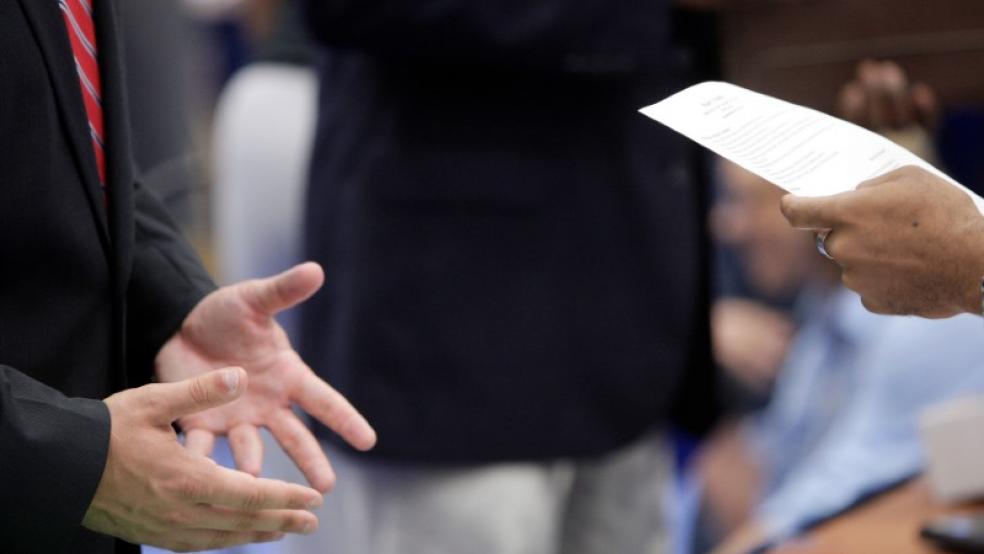The jobs report issued by the Bureau of Labor Statistics on Friday was disappointing in myriad ways. At 138,000, the headline number of jobs created in May was far lower than economists had expected. Wage growth was slow, and the previous two months’ reports were revised downward by a combined 66,000 jobs.
Coupled with the fact that the rate of inflation remains well below the target rate of 2 percent, it was a sobering result, leading many economists to wonder if the economy has entered a long-term phase of slowing job growth that ought to give the Federal Reserve Board pause when its Open Market Committee considers changes to interest rates next month.
Related: Why Trump’s Boost to Military Spending May Not Deliver ‘Jobs, Jobs, Jobs’
However, before getting to the question of the Fed, it’s worth looking at a few numbers in the report that stood out, seeming to contradict all the doom and gloom coming from professional economists. The overall unemployment rate fell to 4.3 percent, the lowest it has been since 2000. And over the past two months, the unemployment rates for men over 20 and for African Americans have both dropped by about half a percentage point -- more than twice the rate of decline for the population as a whole.
This sounds like it ought to be good news, but sadly, it’s not.
The reason why a report finding that the overall unemployment rate has dropped to a 17-year low can still be greeted as bad news is by now fairly well-known. Because of the way the BLS measures unemployment, the topline rate can be driven down for two different reasons. The “good” reason is when the numerator in the ratio of employees-to-total workforce participants goes up. The “bad” reason is when the denominator goes down.
Imagine a country suffering an epidemic. Public health professionals want to see the percentage of sick people decline -- but they want it to decline because people are being cured, not because they’re dying.
Related: Economists Agree: Trump’s Tax Cuts Won’t Pay for Themselves
On balance, what this month’s report shows is the latter situation. Nearly half a million Americans dropped out of the labor force last month, driving down unemployment in the wrong way.
But what explains the apparent gains of men over 20 and of African Americans? In March, the unemployment rate for men over 20 was 4.3 percent. By the end of May, it was 3.8 percent. For African Americans it fell from 8 percent to 7.5 percent.
Unfortunately, there is a similar dynamic at play here. Economist Jared Bernstein, a senior fellow at the Center on Budget and Policy Priorities, points out that much of the change is accounted for by the shift in male workers in general and African American workers out of the labor market in recent months. Adjusted to reflect the fact that the denominator in both employment rate equations had fallen in the May report – that is, there are fewer workers in the workforce -- the changes for both categories fall roughly back into line with the rest of the population.
For men over 20, the participation rate was 72.1 percent in January, falling to 71.8 percent in May. The falloff for African Americans in general has been less dramatic -- only down from 62.5 percent to 62.4 percent from April to May. But for African American men it's been a steadier decline, from 68.1 percent in January down to 67.5 percent in May.
The monthly jobs data, as Bernstein and other economists regularly note, is “noisy,” meaning that month-to-month fluctuations may not be truly significant. But a months-long slowing trend in jobs growth has many economists wondering about the cause.
Related: Trump’s Rosy GDP Projection Masks Larger Economic Growth Concerns
Either employers are butting up against a supply constraint, because lower unemployment rates mean fewer available workers to hire, or the Fed’s slow program of tightening has, by itself, slowed hiring. In the first case, we’re nearing a full-employment situation, which could send inflation rising at rates unacceptable to Fed policymakers, meaning interest rate hikes are more necessary than ever. If the latter is the case, there’s reason to hope the Fed will reconsider its widely-expected increase in interest rates when it meets later this month.
Bernstein falls in the latter camp. While it would fly in the face of market expectations to delay a rate increase, as Bernstein noted on his blog Friday morning, “The Fed’s client is not the stock market. It’s the macroeconomy, and the dual mandate: full employment at stable prices. Given at least some evidence of softening in the job market in tandem with slower core price growth, a data-driven Fed should pause and take stock of where we are.”
However, the consensus among economists appears to be that the members of the FOMC will line up on the side of impending full employment, even though the May report suggests perhaps a little more labor market slack than expected.
In a note that echoed many of his colleagues, Paul Ashworth, chief economist at Capital Economics, wrote Friday morning, “The upshot is that, even if core inflation remains stubbornly below the Fed’s target, it will continue to hike interest rates, with a June rate hike a near-certainty at this stage.”





